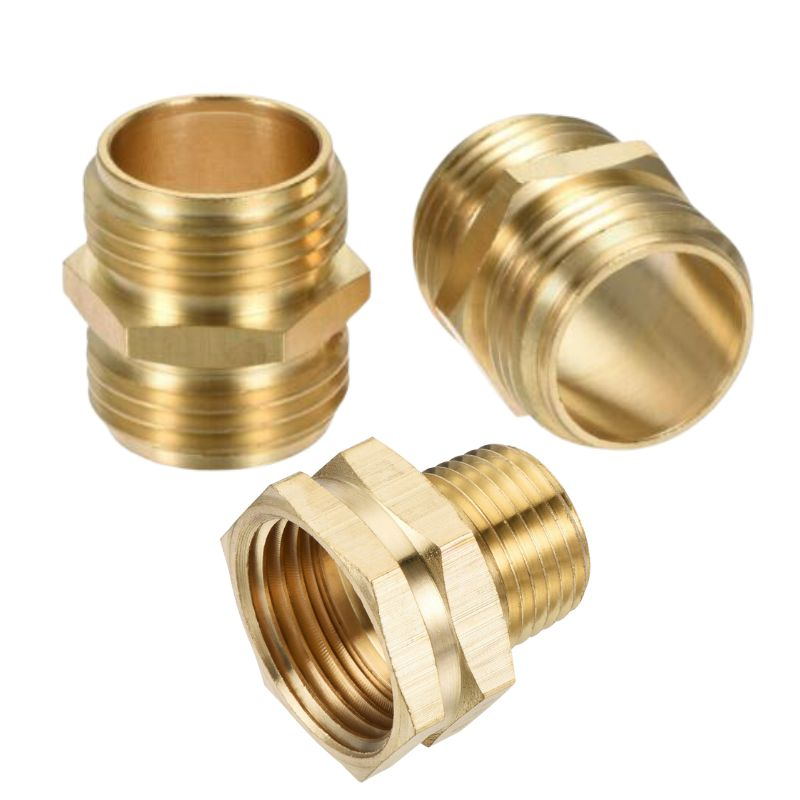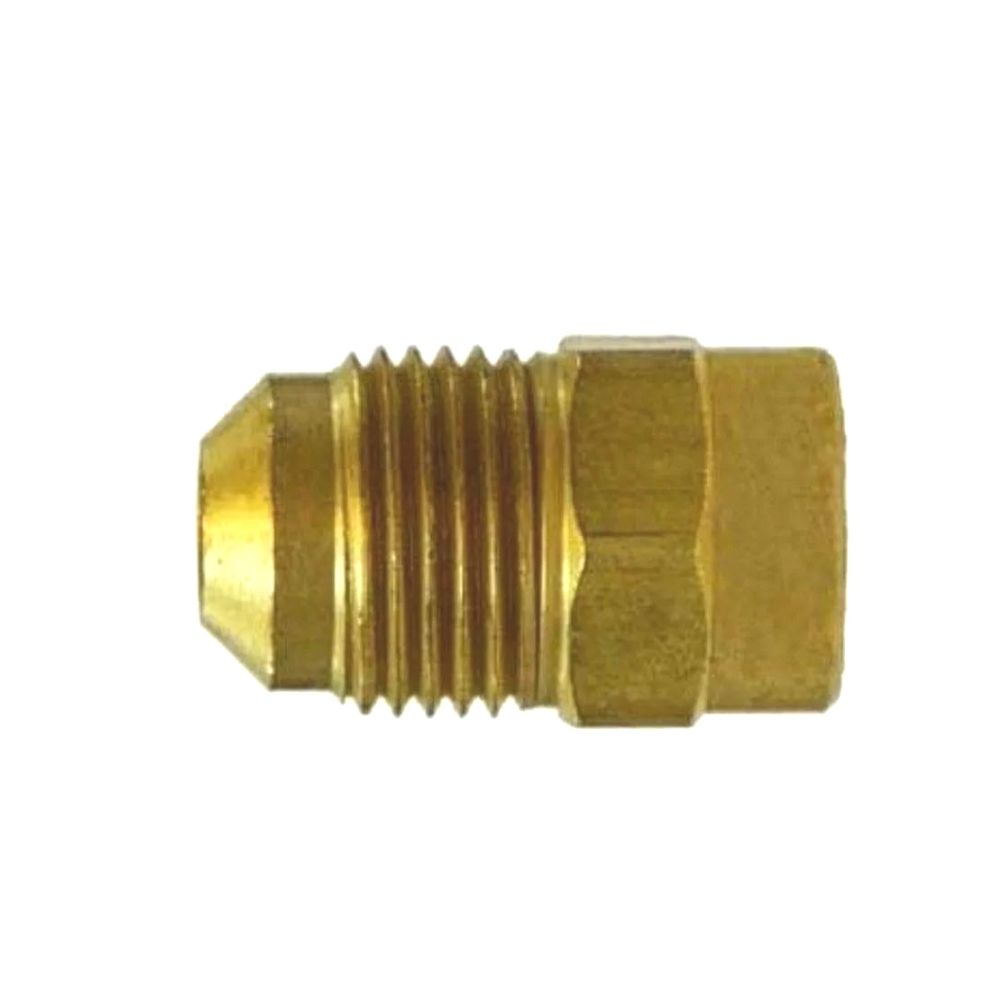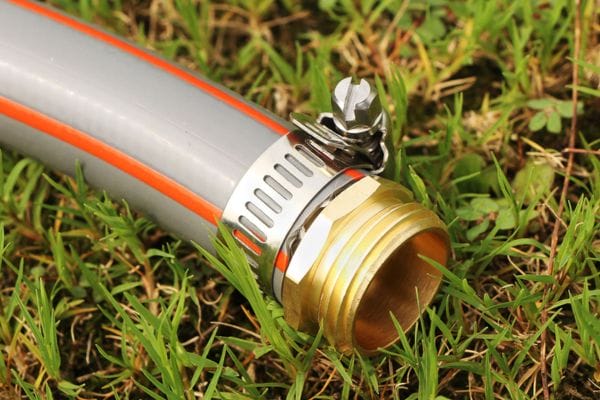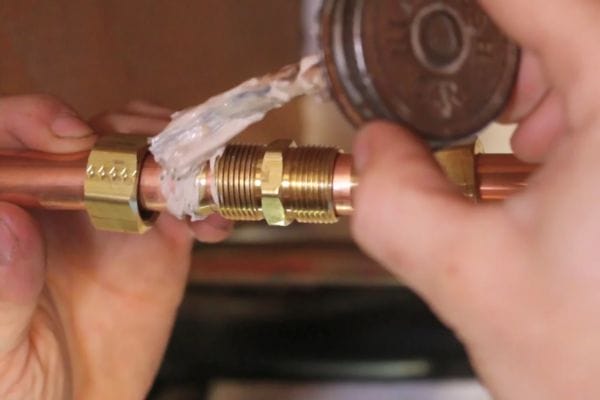Garden hose fittings are essential components that connect hoses to various water sources, such as faucets, sprinklers, and other irrigation systems. These fittings come in various shapes and sizes, designed to ensure a secure and leak-free connection between the hose and its attachment point.
Types of Garden Hose Fitting
Threaded Fittings
Male and Female Threads
- Male Threads: Male threads are external threads that are found on the outside of fittings, such as the ends of hoses, spigots, or other devices. These external threads are designed to be screwed into female threads, creating a tight and secure connection. Male threads are an essential component of many garden hose systems and are widely used in various applications, such as connecting hoses to faucets, sprinklers, or nozzles.
- Female Threads: Female threads, in contrast, are internal threads located inside a fitting. These threads are designed to receive male threads, completing the connection between two pieces of equipment. Female threads are typically found on the receiving ends of hoses, faucets, or tools, where they provide a strong and leak-proof connection. This design allows water to flow through the hose without leaks or pressure loss.
- Common Uses and Compatibility: Male and female threaded fittings are the most common type of connection used in garden hose systems. They are widely utilized for attaching hoses to faucets, sprinklers, nozzles, and various other accessories. The compatibility of male and female threads depends on the type of thread used, such as the National Pipe Thread (NPT) or Garden Hose Thread (GHT). Ensuring the correct match between male and female threads is crucial for achieving a proper connection and preventing leaks.

National Pipe Thread (NPT)
- Characteristics: National Pipe Thread (NPT) is a type of thread commonly used in plumbing and hose connections, especially in applications outside of garden hoses. NPT threads are unique because they are tapered, which means the threads become narrower as they are screwed into place. This tapered design creates a tighter and more secure seal as the fitting is tightened, which helps to prevent leaks. In many cases, the connection is further enhanced by the application of thread tape (Teflon tape) or thread sealant to ensure a leak-proof seal.
- Typical Applications: NPT threads are often used in industrial and commercial plumbing systems, air and water piping, and various other applications. While they are not commonly found on garden hoses, they are frequently used for heavy-duty hose connections where a more secure and durable seal is required. For instance, NPT fittings might be used in irrigation systems, HVAC applications, and pressure washer hoses. Their versatility and durability make them a popular choice in settings where secure connections and leak prevention are critical.
Garden Hose Thread (GHT)
- Explanation: Garden Hose Thread (GHT) is the standard type of thread used on garden hoses and related accessories in the United States. Unlike NPT threads, which are tapered, GHT threads are straight, meaning they maintain a consistent diameter throughout the length of the thread. This straight thread structure allows for easier attachment and detachment of hoses and accessories, making GHT fittings more user-friendly for everyday garden applications.
- Differences from NPT: GHT and NPT threads differ in several key ways. GHT threads are generally coarser and straight, while NPT threads are finer and tapered. GHT is specifically designed for garden hoses, where ease of use and quick connections are important. NPT, on the other hand, is more versatile and is used for a wider range of applications beyond garden hoses, particularly where a tighter, more secure seal is necessary.
Quick Connectors
Types of Quick Connectors
- Standard quick connectors are designed to allow users to easily and quickly attach and detach hoses, sprinklers, nozzles, and other accessories without the need for twisting or threading. These connectors typically come in two parts: one part that attaches to the end of the hose, and another that attaches to the faucet, spigot, or accessory. When the two parts are snapped together, they create a secure connection that allows water to flow through the system.
- Specialized Quick Connectors: In addition to standard quick connectors, there are also specialized versions designed for specific tasks. For example, some quick connectors are built to handle high-pressure applications, such as those found in pressure washers or irrigation systems. These connectors are often made from more durable materials like brass or stainless steel to withstand the increased pressure and prevent leaks. Other specialized quick connectors may be designed for connecting hoses to specific types of equipment, such as RVs, boats, or industrial machinery.
Advantages and Disadvantages
- Pros: The primary advantage of quick connectors is their convenience. They allow users to quickly change tools and accessories without the hassle of screwing and unscrewing threaded fittings. This can save time and effort, especially for those who need to switch between multiple tools or move hoses frequently. Quick connectors are also user-friendly, making them ideal for people who may have difficulty handling traditional threaded fittings.
- Cons: One potential drawback of quick connectors is that they can be prone to leaks if they are not properly sealed or if they are made from lower-quality materials. If the connection between the two parts of the quick connector is not secure, water may seep out, leading to wasted water and reduced pressure.
Adapters and Couplers
Functionality
- Adapters: Adapters are specialized fittings that allow users to connect hoses or tools with different sizes or thread types. For example, an adapter might be used to connect a hose with a 3/4-inch fitting to a nozzle with a 1/2-inch fitting. Adapters can also be used to convert between different types of threads, such as connecting a GHT hose to an NPT faucet. This versatility makes adapters an essential tool for anyone working with multiple hose sizes or thread types.
- Examples: Some common examples of adapters include reducing couplers, which allow a larger hose to be connected to a smaller tool, and cross-thread adapters, which enable users to connect hoses with different thread types (e.g., NPT to GHT). These adapters ensure that hoses and tools of different sizes and types can still be used together, providing flexibility and convenience for gardeners and professionals alike.

Types of Adapters
- Reducing or Expanding Adapters: These adapters are used to connect hoses and tools of different sizes. For example, if you have a 3/4-inch hose and need to connect it to a 1/2-inch nozzle, a reducing adapter can bridge the gap and make the connection possible. Similarly, expanding adapters allow smaller hoses to be connected to larger tools.
- Thread Converters: These adapters allow users to connect hoses with different thread types. For example, if you have a hose with NPT threads and need to connect it to a faucet with GHT threads, a thread converter adapter can be used to make the connection. This is particularly useful for people who need to use hoses and accessories from different regions or industries, where different thread standards may be in place.
Understanding Hose Fitting Sizes
Common Sizes and Measurements
Typical Garden Hose Sizes
- 1/2 Inch: This size is generally used for light residential tasks, such as watering small gardens or flower beds. It is ideal for shorter hoses and low water pressure applications.
- 5/8 Inch: The most common size for residential garden hoses. It strikes a balance between water flow and ease of handling, making it suitable for most home watering tasks, such as lawn care, washing cars, and gardening.
- 3/4 Inch: Larger hoses are used mainly for commercial purposes or larger-scale residential watering. These hoses allow for higher water flow, making them suitable for irrigation systems, large gardens, and heavy-duty cleaning tasks.
Standard Sizes and Where They Are Used
- Residential Use: Homeowners generally opt for 1/2-inch or 5/8-inch hoses for everyday tasks around the yard and garden.
- Commercial Use: For heavier applications, like farm or landscaping work, 3/4-inch hoses are favored for their higher capacity and flow rate.
Measurement Units
How to Measure Hose Diameter and Fittings
- Inner Diameter (ID): The internal measurement of the hose or fitting. This is the key measurement that determines how much water can flow through the hose. For example, a 5/8 inch hose has a 5/8 inch inner diameter.
- Outer Diameter (OD): The external measurement of the hose or fitting. Although less commonly used for garden hoses, this measurement is important for some fitting applications.
- Measuring: To measure your hose’s diameter, you can use a caliper or ruler to measure the internal or external opening of the hose.
Size Compatibility
Matching Hose to Fittings
- Guide: To avoid leaks and ensure optimal performance, it is essential to match the hose size (ID) with the corresponding fitting size. For instance, a 5/8 inch hose should be paired with a 5/8 inch fitting. This creates a snug fit that prevents leaks and maintains water pressure.
- Tip: Always check the fitting’s labeling for compatibility with the hose size to avoid mismatches.
Conversion Between Metric and Imperial Sizes
- Tips for Conversion: Hose sizes are often listed in imperial units (inches) in the U.S., while some fittings might be available in metric units. For instance, a common conversion is between 15mm (metric) and 5/8 inch (imperial). A simple conversion chart or calculator can help ensure you choose the correct size.
- Example: 1 inch is equivalent to 25.4mm, so knowing this conversion can help when shopping for hoses or fittings that may be listed in different units.

Choosing the Right Size
Factors to Consider
- Hose Length: The longer the hose, the more water pressure is likely to drop over the distance. For longer hoses, consider using a larger diameter hose (e.g., 3/4 inch) to maintain adequate water flow.
- Water Pressure: If your water pressure is low, opting for a smaller diameter hose (e.g., 1/2 inch) may help by reducing the volume of water and increasing the force with which it is delivered.
- Intended Use: Different tasks may require different hose sizes. For example, a 5/8-inch hose is versatile for general garden tasks, while a 3/4-inch hose is better suited for high-demand applications like irrigation or power washing.
How Size Affects Performance
- Water Flow and Pressure: Larger hoses and fittings allow for higher water flow, which is ideal for tasks like irrigation or washing large surfaces. However, they may reduce water pressure over long distances or low-pressure systems. Smaller hoses and fittings deliver less water but may provide higher pressure, making them ideal for targeted watering, such as flower beds or small gardens.
- Efficiency: Choose the right size to balance flow and pressure for your specific needs. For instance, a 3/4-inch hose may be overkill for a small backyard garden, while a 1/2-inch hose might not provide enough flow for a larger job.
Tips for Installing and Maintaining Garden Hose Fittings
Installation Tips
Proper Technique
Step-by-Step Instructions for Securely Connecting Fittings:
- Prepare the Hose: Ensure the end of the hose is clean and cut straight. A clean cut ensures a better seal when attaching fittings.
- Insert the Fitting: If installing a threaded fitting, gently insert the male or female thread into the hose end.
- Hand-Tightening: Begin by hand-tightening the fitting to the hose or faucet. Hand-tightening is usually sufficient for garden hoses, as over-tightening with tools can cause damage to the threads.
- Using Tools (If Necessary): If hand-tightening doesn’t fully secure the connection or if you’re dealing with stubborn fittings, use an adjustable wrench or pliers to gently tighten. Avoid applying excessive force, as this can strip threads or crush fittings.

Preventing Leaks
Using Teflon Tape or Thread Sealant:
- Apply Teflon Tape: Wrap Teflon tape around the threads of the fitting in a clockwise direction. This helps create a watertight seal and prevents leaks.
- Use Thread Sealant: As an alternative to Teflon tape, you can apply thread sealant (often referred to as pipe dope) to the threads for a more secure seal, especially in high-pressure situations.
- Final Check: After installing the fitting and tightening it securely, turn on the water to check for any leaks. If you notice any, tighten slightly more or reapply the sealant.
Maintenance
Regular Inspection
Guide on Checking for Wear and Tear:
- Frequency: Inspect fittings every few months, especially at the beginning and end of the watering season.
- What to Look For: Check for cracks, corrosion, or discoloration in both metal and plastic fittings. Examine the washers and O-rings inside the fittings for signs of wear, brittleness, or compression.
- Preventive Action: Replace any damaged or worn-out parts immediately to avoid leaks or failures.
Cleaning and Storage
Best Practices for Cleaning Fittings:
- Remove Dirt and Debris: Clean the outside and inside of the fittings with a soft brush and mild detergent to remove dirt, mineral deposits, or any buildup that could affect performance.
- Dry Thoroughly: After cleaning, dry the fittings completely before storage to prevent rust or mildew growth.
Proper Storage Tips:
- Store Indoors: During the off-season, disconnect hoses from faucets and store both hoses and fittings in a cool, dry place. Storing them indoors prevents freezing, which can cause cracks and leaks in both the hose and fittings.
- Avoid Kinks: Store hoses loosely coiled to avoid kinking, which can damage the hose and affect fitting performance.
Troubleshooting Common Issues
Leaking Fittings
How to Identify and Fix Leaks:
- Check Washers: Often, leaks occur because washers inside the fittings have worn out or are missing. Replace worn washers with new ones that fit snugly inside the fitting.
- Inspect Threads: Look for any damage or cross-threading in the male and female threads. Damaged threads may not create a proper seal and can cause leaks.
- Reapply Sealant: For persistent leaks, try reapplying Teflon tape or thread sealant to the threads to ensure a tight, waterproof connection.
Difficulty Connecting or Disconnecting
Solutions for Stuck Fittings:
- Lubricate Threads: Apply a small amount of lubricant (such as silicone-based grease) to the threads before connecting. This can prevent fittings from sticking and make them easier to unscrew later.
- Avoid Overtightening: Over-tightening fittings can make them difficult to disconnect and may damage the threads. Hand-tighten initially, and only use tools for minor adjustments.
- Heat Application: If fittings are stuck due to mineral buildup or corrosion, try applying heat (e.g., warm water) to expand the metal slightly and loosen the connection.
Conclusion
Choosing the right garden fittings is critical to improving performance and longevity. Whether it’s a threaded fitting, quick connector, or adapter, knowing their type and size can help prevent leaks and ensure water flows freely. Regularly inspecting existing fittings and replacing worn parts promptly will not only improve efficiency but also conserve water. For additional help or products, please refer to our resources and store.
FAQ
What are the most common types of garden hose fittings?
The most common types are threaded fittings (male and female threads), quick connectors, and adapters.
How do I know if my garden hose fitting is male or female?
Male fittings have external threads that screw into female fittings with internal threads. Check if the fitting has threads on the outside (male) or inside (female).
What is the difference between NPT and GHT fittings?
NPT (National Pipe Thread) fittings are tapered and often used in high-pressure systems, while GHT (Garden Hose Thread) fittings are non-tapered and commonly used in residential garden hoses.
Can I use quick connectors with any garden hose?
Most quick connectors are designed to be compatible with standard garden hoses but always check for compatibility with your specific hose and fittings.
How do adapters help with garden hose connections?
Adapters allow you to connect hoses or equipment with different sizes or thread types, making it easier to customize your setup.
Are there any disadvantages to using quick connectors?
Quick connectors can sometimes develop leaks if not properly secured or maintained, and they may not be as durable as threaded fittings in some applications.





